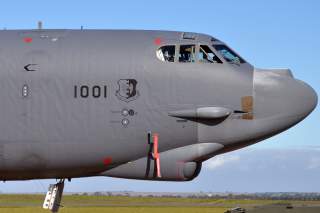Operation Secret Squirrel: How B-52 Bombers Flew Around the Clock to Start a War
Against who?
In the early morning of Jan. 16, 1991, the U.S. Air Force (USAF) deployed seven B-52G Stratofortresses crews from 2nd Bomb Wing (BW) to Iraq in a single, secret mission that would mark the beginning of Operation Desert Storm.
This opening salvo, launched by the 596th Bomb Squadron (BS), paved the way for American forces to defeat Iraqi dictator Saddam Hussein, whose troops had invaded neighboring Kuwait. The then Strategic Air
Command (SAC) called the classified mission Operation Senior Surprise.
Operation Senior Surprise was a mission orchestrated by SAC during Operation Desert Shield. The term Senior Surprise was the official name of the mission, but aircrew and maintainers creatively came up with the name Secret Squirrel so they could track schedules and discuss the mission in unclassified areas.
At the start of Desert Shield, a select group of aircrew and maintainers from the 596th Bomb Squadron (BS) were briefed about the use in combat of a new type of weapon, the Conventional Air Launched Cruise Missile (CALCM).
“I was first informed of the mission in August 1990 and then had six months to train on the new weapon. We couldn’t tell anybody anything,” explained Warren Ward, Air Force Global Strike Command (AFGSC) deputy chief of programming division and 596th BS B-52G Stratofortress co-pilot, during Operation Senior Surprise. “The 62nd BS and part of the 596th BS were largely deploying forward yet a large portion of the 596th stayed at Barksdale. We were watching our brothers in arms going forward, yet we were staying back. We had to work under a veil of secrecy.”
Once briefed, the groups began extensive training to ensure that the aircraft could fly long-range missions safely and flawlessly.
The morning of Jan. 16, 1991, seven B-52G Stratofortresses from Barksdale Air Force Base (AFB) took off heading toward Iraqi targets, launched 35 of the then new AGM-86C CALCMs annihilating Saddam’s forces and striking key point of communication infrastructure, and returned in secret.
This marked also the first time GPS had ever been used to guide a missile toward a target.
Col. Trey Morriss, 307th BW vice commander, was a new captain when he served as a B-52G electronic warfare officer during the Secret Squirrel mission.
“The Secret Squirrel mission was used to blind Iraq by eliminating certain power and communication nodes throughout the country. This severely hampered their response in the initial phase of the war,” Morriss pointed out. “We proved to U.S. citizens, our allies, coalition partners, and even to our enemies that we will do what we say we’re going to do. In doing so, we solidified the B-52 in the realm of long-range strike capability.”
“The B-52 provides a great first-strike capability in any conventional war,” Morriss said. “It gives us the ability to degrade the enemy with the first attack and press in with other capabilities. We also proved to the world that we were on the threshold of a new type of modern warfare with GPS-guided weapons. The results speak for themselves.”
Noteworthy during “Secret Squirrel” the BUFF (Big Ugly Fat Fucker, as the B-52 is nicknamed) aircrews faced unpredictable risks when flying to the Middle East, but maintained confidence in their training. Those risks included potential enemy action, landing into friendly territory that may not have been prepared to accommodate U.S. military aircraft or any number of system failures within the aircraft.
“The risks were the unknown,” explains Russell Mathers. who took part to Secret Squirrel as B-52 copilot “We didn’t know if anyone was going to take a shot at us.”
Secret Squirrel marked the longest combat sortie flight totaling 14,000 miles in 35 hours and 24 minutes. Moreover the clandestine operation set the standard for long-range strike.
In fact as told by Mathers, after Desert Storm SAC learned valuable lessons about long-range combat missions. “What we learned as a bomber community is that the bomber is still a huge viable weapons system. We also learned how difficult it is physiologically, to fly these missions and prepare the human body to fly 30 or 40 hour missions.”
Once “Secret Squirrel” kicked off Desert Storm operations, the B-52 continued playing a critical role throughout the campaign. In fact nearly 70 B-52G crews flew 1,741 missions totaling 15,269 combat hours during which 27,000 tons of munitions were dropped.
Jim Bowles, an AFGSC program analyst, served as a B-52 instructor pilot and aircraft commander during Desert Storm. Bowles said he was fortunate to fly with a copilot, radar navigator electronic warfare officer, and gunner, all of whom were instructors in their respective duties. “We knew our aircraft, and we knew our training. While there was some apprehension about going into combat and the potential for not coming home, there was also a confidence because we knew we could do our mission. When I look back on Desert Storm, it feels like yesterday. It’s a memory deep within myself and my family. It’s a defining moment that shaped me for the rest of my Air Force career.”
Secret Squirrel remained classified until Jan. 16, 1992, when the aircrew members and maintainers who made the mission possible were presented with air, achievement and commendation medals for their efforts.
This story first appeared in The Aviation Geek Club in November 2016.
Image: Wikimedia Commons

